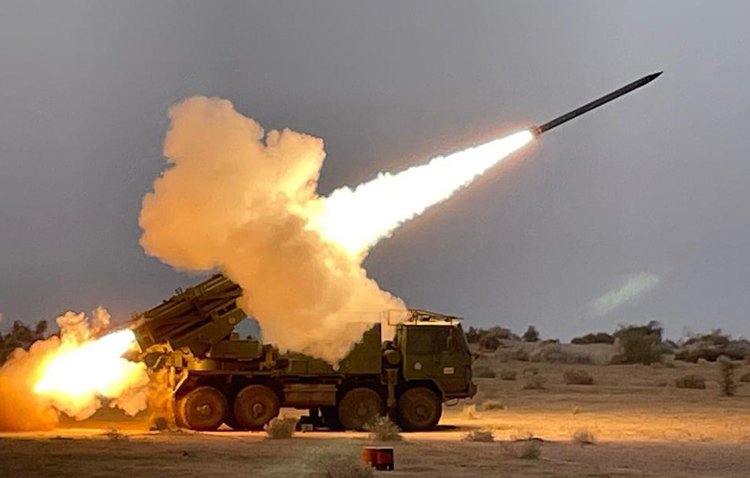INDIAN ARMED FORCES CHIEFS ON OUR RELENTLESS AND FOCUSED PUBLISHING EFFORTS

The insightful articles, inspiring narrations and analytical perspectives presented by the Editorial Team, establish an alluring connect with the reader. My compliments and best wishes to SP Guide Publications.

"Over the past 60 years, the growth of SP Guide Publications has mirrored the rising stature of Indian Navy. Its well-researched and informative magazines on Defence and Aerospace sector have served to shape an educated opinion of our military personnel, policy makers and the public alike. I wish SP's Publication team continued success, fair winds and following seas in all future endeavour!"

Since, its inception in 1964, SP Guide Publications has consistently demonstrated commitment to high-quality journalism in the aerospace and defence sectors, earning a well-deserved reputation as Asia's largest media house in this domain. I wish SP Guide Publications continued success in its pursuit of excellence.
- Operation Sindoor: Resolute yet Restrained
- India’s Operation Sindoor Sends a Clear Message to Terror and the World – ‘ZERO TOLERANCE’
- Japan and India set forth a defence cooperation consultancy framework, talks on tank and jet engines
- Terrorist Attack in Pahalgam in Kashmir: Unfolding a long surgical war against PAK
- Lt General Pratik Sharma takes over Command of Indian Army's Northern Command
VL-SRSAM and Pinaka-ER Tested
The VL-SRSAM, based on Astra Mark-1 air-to-air missile, is a quick reaction surface-to-air missile which has a maximum speed of Mach 4-5 and was conceived for area and point defence to protect naval platforms
 |
The Author is Former Director General of Information Systems and A Special Forces Veteran, Indian Army |

The Defence Research and Development Organisation (DRDO) officials announced on December 7, 2021, that India has successfully test-fired the Vertically Launched Short Range Surface to Air Missile (VL-SRSAM) from the Integrated Test Range (ITR), Chandipur of the coast of Bay of Bengal in Odisha. It involved testing the high-speed expendable aerial target (HEAT), ABHYAS, used for evaluation of various missile systems. The air defence system, which can engage approaching targets, is being developed by DRDO for naval warships and this test was done in the presence of senior naval officers.
On February 22, 2021, DRDO had first test-fired two VL-SRSAM of the Odisha coast. The maiden launch tested the efficacy of vertical launch system and missile's maximum and minimum range. Both the missile successfully intercepted their target with pin point accuracy. The launch on December 7, 2021, was conducted from a vertical launcher against an electronic target at a very low altitude. The launch was conducted to validate integrated operation of all weapon system components including the vertical launcher unit with controller, canisterised flight vehicle, weapon control system etc. The missile hit an electronic target at a range of 60 km.
India has successfully test-fired the Vertically Launched Short Range Surface to Air Missile (VL-SRSAM). The air defence system, which can engage approaching targets, is being developed by DRDO for naval warships.
Defence Research and Development Laboratory (DRDL), Research Centre Imarat (RCI) of Research and Development (Engineers) and some private sector industries were involved in the design and development of the VL-SRSAM missile system as part of Development-cum-Production Partner programme (DCPP). VL-SRSAM superseded the cancelled Maitri missile project undertaken jointly by MBDA and DRDO based on the work done on MICA and Trishul missile systems.
The VL-SRSAM is based on Astra Mark-1 air-to-air missile with four short-span cruciform wings that provide aerodynamic stability. It also includes additional jet vanedriven thrust vector control to enable quick reaction time on vertical launch and smokeless exhaust. VL-SRSAM was conceived for area and point defence to protect naval platforms.
The VL-SRSAM is a quick reaction surface-to-air missile which has a maximum speed of Mach 4-5,During mid-course flight, the missile uses fibre optics gyroscope based inertial guidance mechanism while in the terminal phase it uses active radar homing. With lock on before launch (LOBL) and lock on after launch (LOAL) capability, the missile receives mid-course update via data link. The VL-SRSAM is reportedly to replace older Barak-1 surface to air missile system onboard warships of the Indian Navy. Interestingly, it will also be used by the Indian Air Force (IAF) asa short range air defence system.
The VL-SRSAM missile system is planned to be offloaded to an indigenous private firm under the ‘Atmanirbhar Bharat’ initiative. This will be the very first time that a private company will be engaged in manufacture of such a missile system.
Each Vertical Launch System (VLS) can hold forty missiles in a twin quad-pack canister configuration carrying eight missiles each for hot launch that can be installed in an arrangement of multiple launch systems based on availability of space on the warship. The missile is for neutralising various aerial threats at medium and close ranges, including enemy fighter aircraft and sea skimming anti-ship missiles. As an integrated solution of missile and weapon control system (WCS) with 360° interception capability, it can detect and engage threats from different directions.
For the manufacturing, the VL-SRSAM missile system is planned to be offloaded to an indigenous private firm under the ‘Atmanirbhar Bharat’ initiative. This will be the very first time that a private company will be engaged in manufacture of such a missile system. Involvement of the private sector should also speed up production.

On December 11, 2021, the Ministry of Defence (MoD) announced the successful test-firing of the Extended Range Pinaka rocket system (Pinaka-ER); over the last three days, 24 rockets were fired for testing different ranges and warhead capabilities. The MoD statement said, "The DRDO, along with the Army, conducted series of performance evaluation trials of these industry produced rockets at field firing ranges during the last three days. In these trials, enhanced range Pinaka rockets were test-fired at different ranges with various warhead capabilities. All the trial objectives were met satisfactorily."
The rocket systems that were tested at Pokharan field firing ranges were manufactured by a private industry following transfer of technology by the DRDO. The rocket system has been jointly designed by two Pune-based DRDO laboratories - the Armament Research and Development Establishment (ARDE) and the High Energy Materials Research Laboratory (HEMRL).
Enhanced range Pinaka rockets were test-fired at different ranges with various warhead capabilities. All the trial objectives were met satisfactorily.The rocket systems that were tested were manufactured by a private industry following transfer of technology by the DRDO.
According to the MoD, the Area Denial Munition (ADM) variants of the munitions for Pinaka, produced under the technology transfer of technology (ToT) were also tested successfully at Pokhran field firing ranges. MoD also said, "With this, the initial phase of technology absorption of Pinaka-ER by the industry partner has successfully been completed making the industry partner ready for series production of the rocket system."
The MoD statement says, "The industry partner has manufactured enhanced Pinaka Mk-1 rockets with DRDO's handholding during the production and quality assurance. In continuation of the transfer of technology absorption, rockets developed by the industry have undergone the performance evaluation and quality certification process. The indigenously-developed "proximity fuzes" for Pinaka rockets have also been tested. After design validation trials, dynamic performance evaluation of these fuzes has been done with flight testing. Consistency in performance of fuzes has been established in consecutive flight trials."
The Pinaka MK-I rocket system has a range of around 40 km and the Pinaka II variant can hit targets at a distance of 60 km. The exact range of the Pinaka-ER (MK-I variant) is not known but it is likely to be around 70 km. The VL-SRSAM missile system and the Pinaka-ER will be a big boost to the firepower of the Indian Military.





